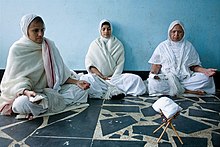|
Aryika
 Aryika, also known as Sadhvi, is a female mendicant (nun) in Jainism.[1]
HistoryIn the traditional Digambara tradition, a male human being is considered closest to the apex with the potential to achieve liberation, particularly through asceticism. Women must gain karmic merit, to be reborn as man, and only then can they achieve spiritual liberation in the Digambara sect of Jainism.[2][3] This view is different from the Svetambara sect that believes that women too can achieve liberation from Saṃsāra by being mendicants and through ascetic practices.[3][4] According to Svetambara Jain texts, from Kalpa Sūtra onwards, Jainism has had more sadhvis than sadhus (female than male mendicants). In Tapa Gacch of the modern era, the ratio of sadhvis to sadhus (nuns to monks) is about 3.5 to 1. This is much higher, and in contrast to the gender ratio historically observed in Buddhism and Hinduism.[5].According to a 2009 publication by Harvey J. Sindima, Jain monastic community had 6,000 sadhvis of which less than 100 belong to the Digambara tradition and rest to Śvetāmbara.[6] Traditionally, in contrast to Svetambara, the Digambara sect has had far less sadhvis.[7] In contemporary times, some Digambara organizations include sandhvis, but the ratio of sadhvis to sadhus (nuns to monks) has been about 1 to 3.[8] ConductA Sadhvi, like a Sadhu, enters the mendicant order by making the Five vows: Ahimsa (Non-violence or Non-injury), Satya (Truthfulness), Asteya (Non-stealing), Brahmacharya (Abstinence from sex and sensual pleasures), and Aparigraha (Non-attachment).[9][10] Describing the conduct of aryikas, Champat Rai Jain in his book, Sannyāsa Dharma writes:
Jains supporting the spiritual liberation of womankind note that their conduct is inclusive in such a path: "It is by way of the Three Jewels that one attains moksa. Nowhere in the Agamas is it stated that women are unable to realise these Three Jewels" (the right faith, right knowledge, and right conduct).[12] See alsoNotes
References
|
